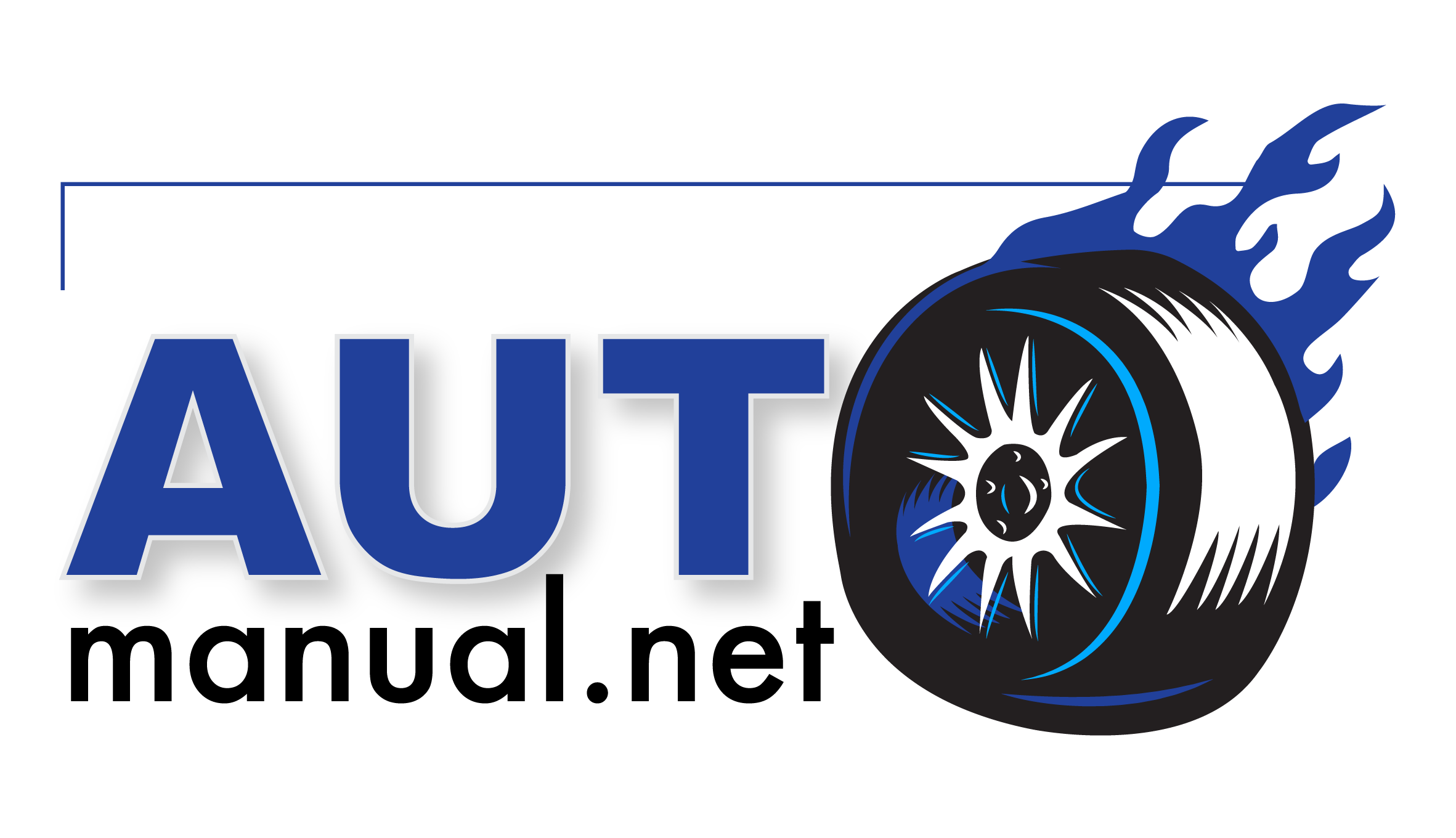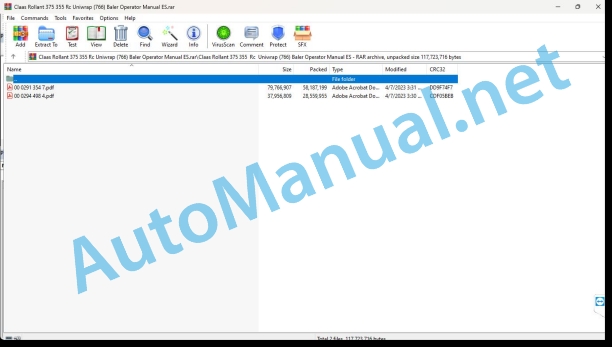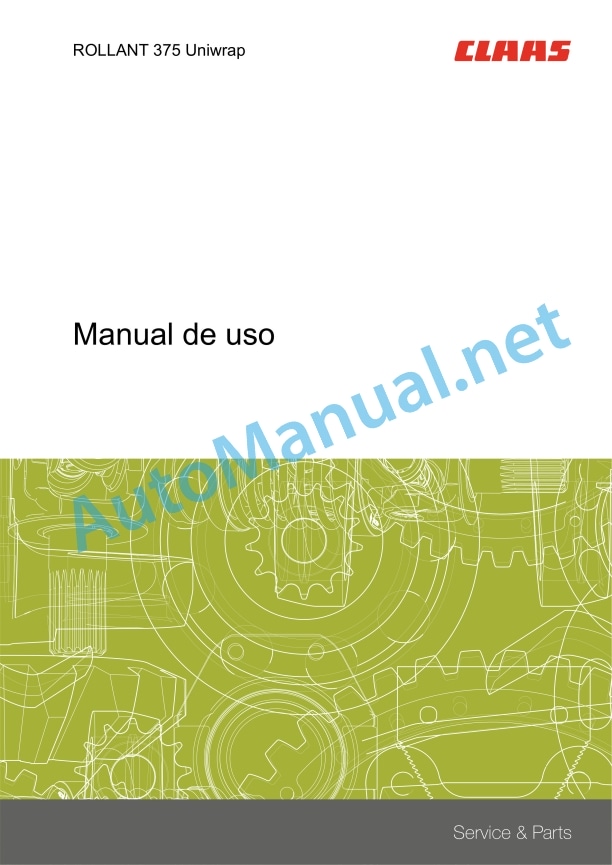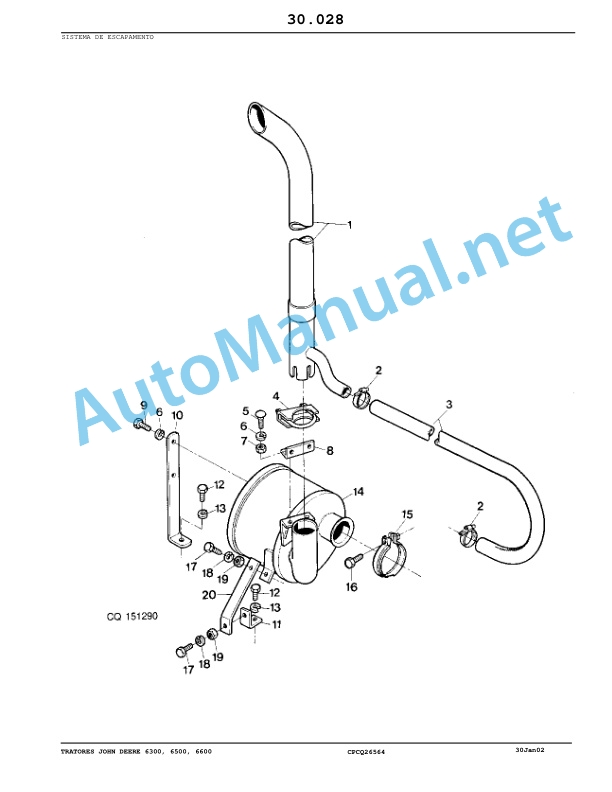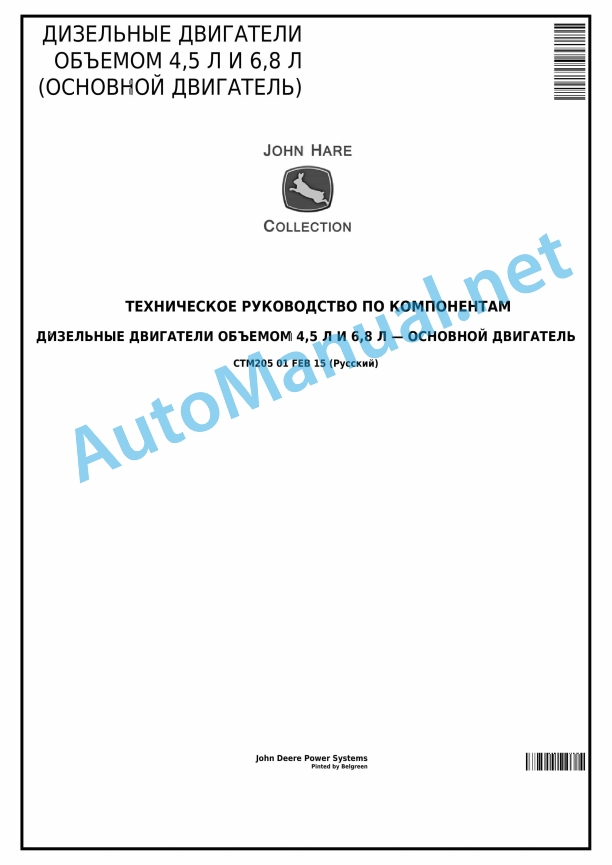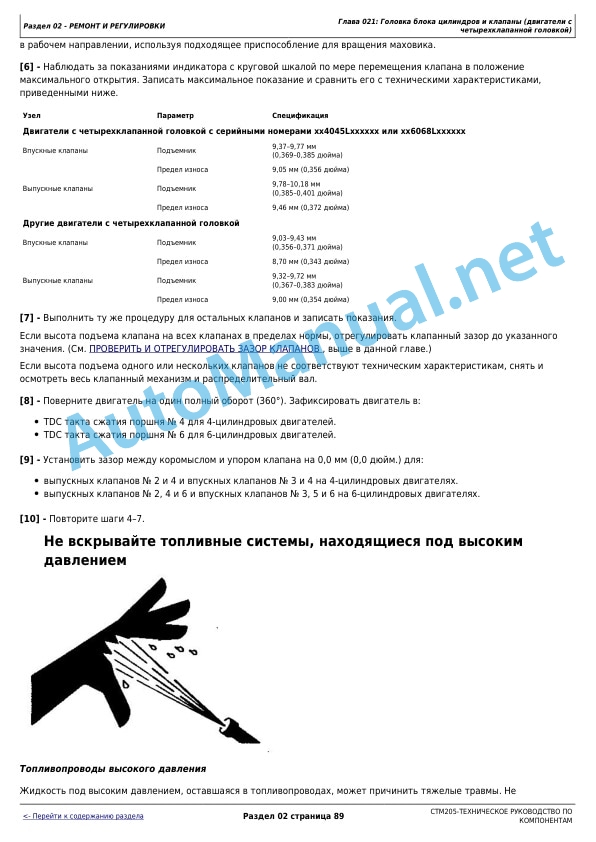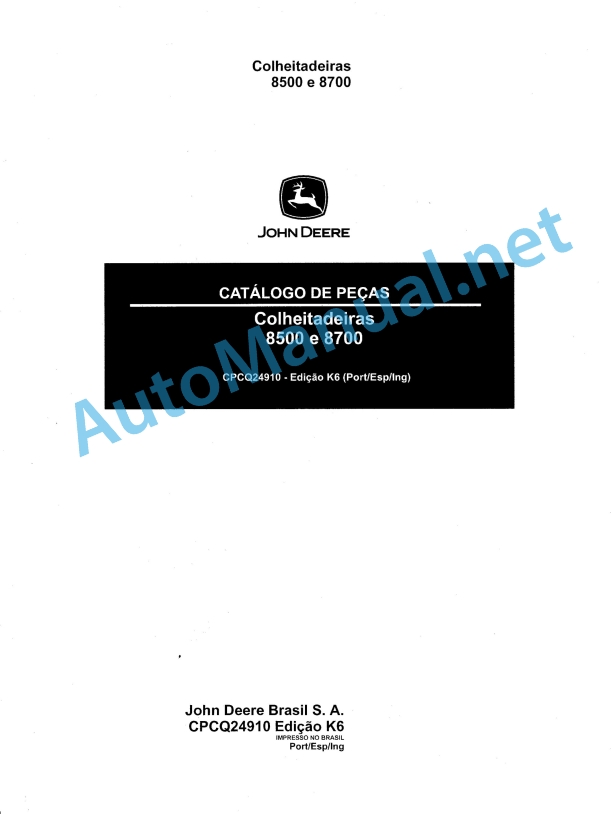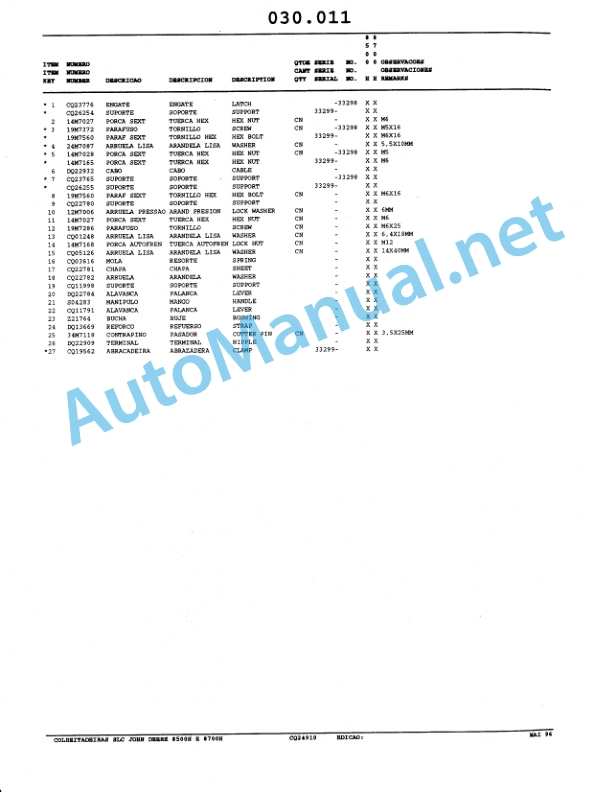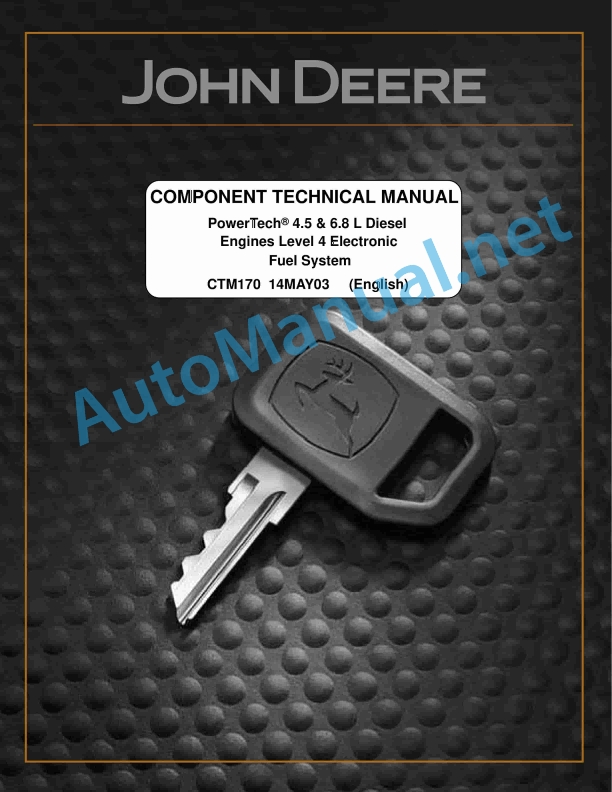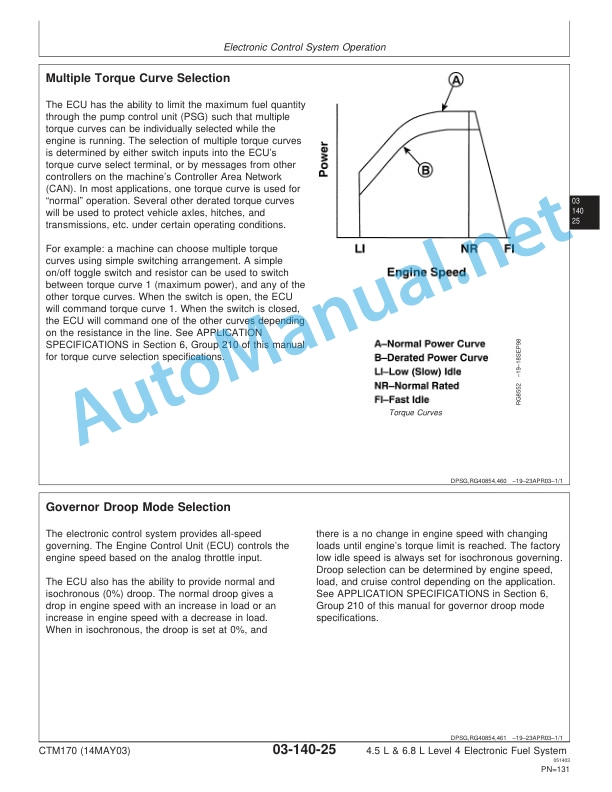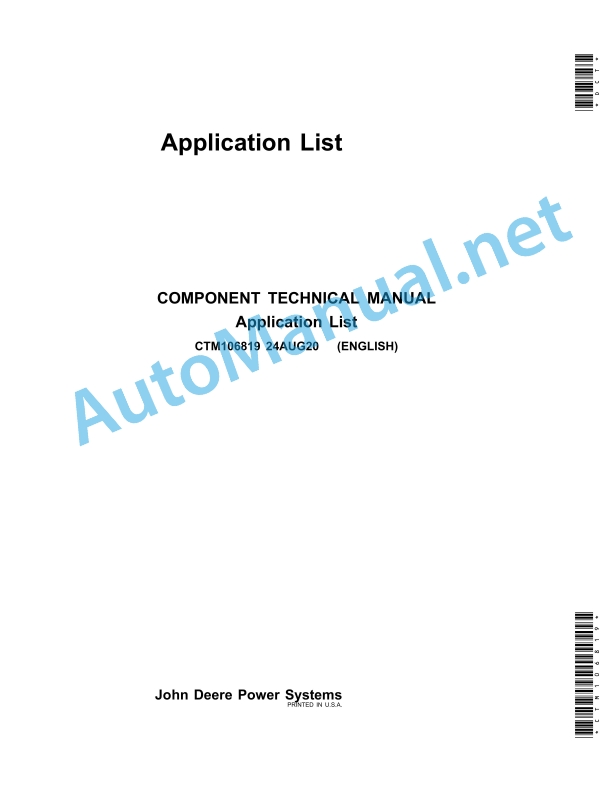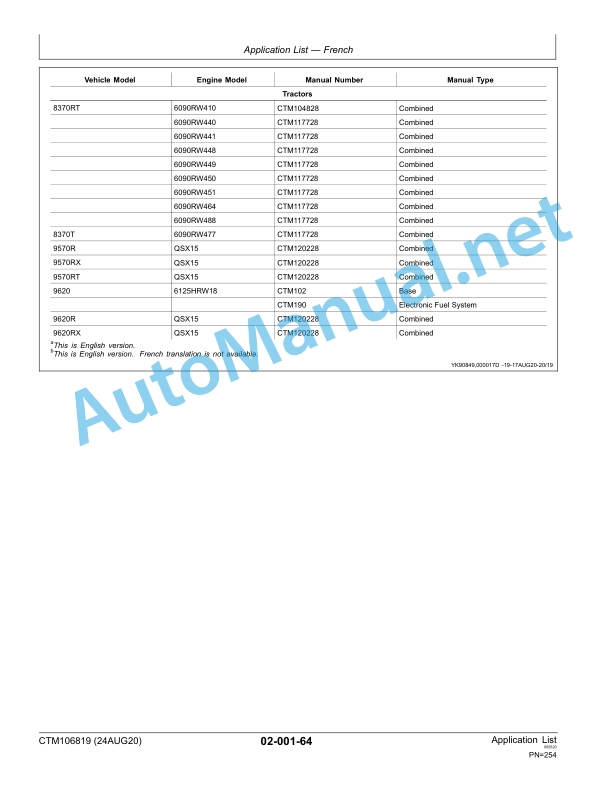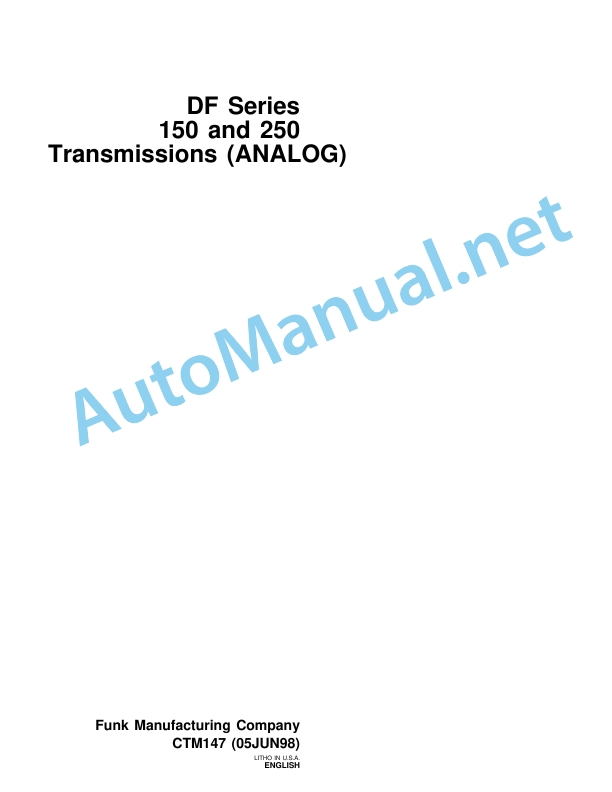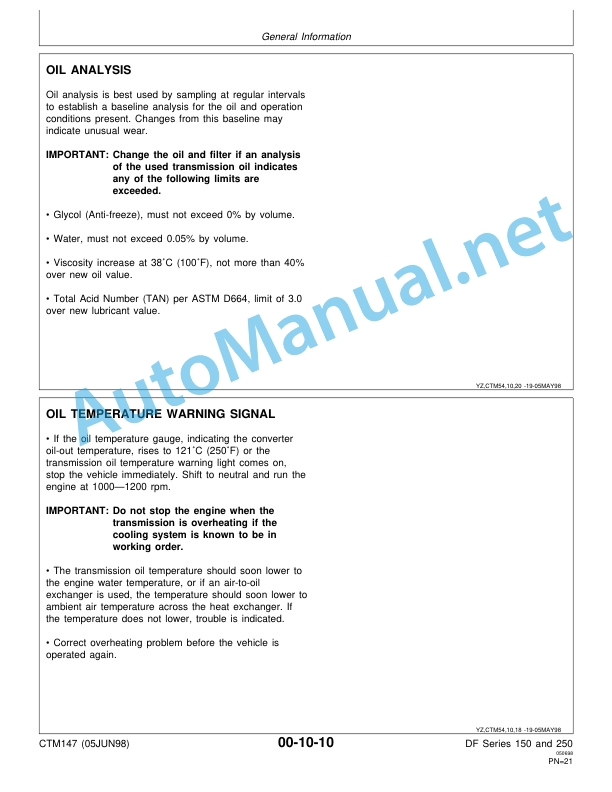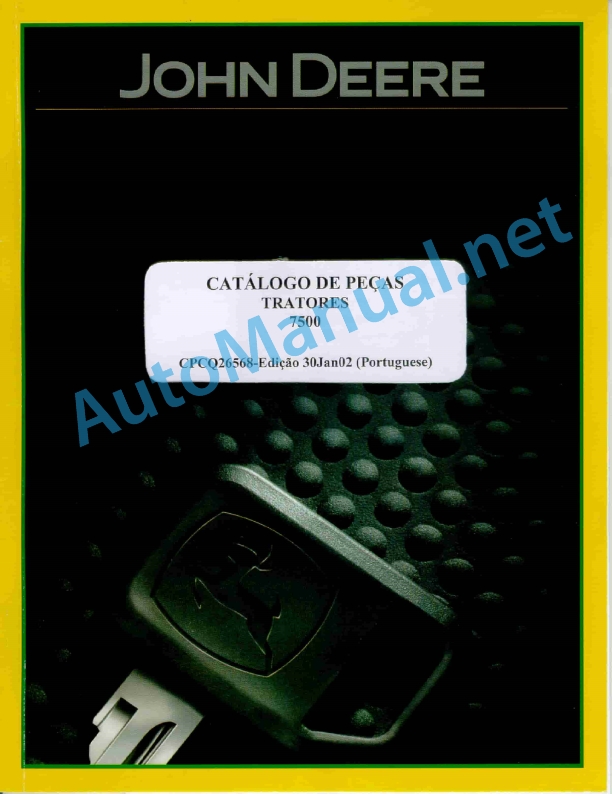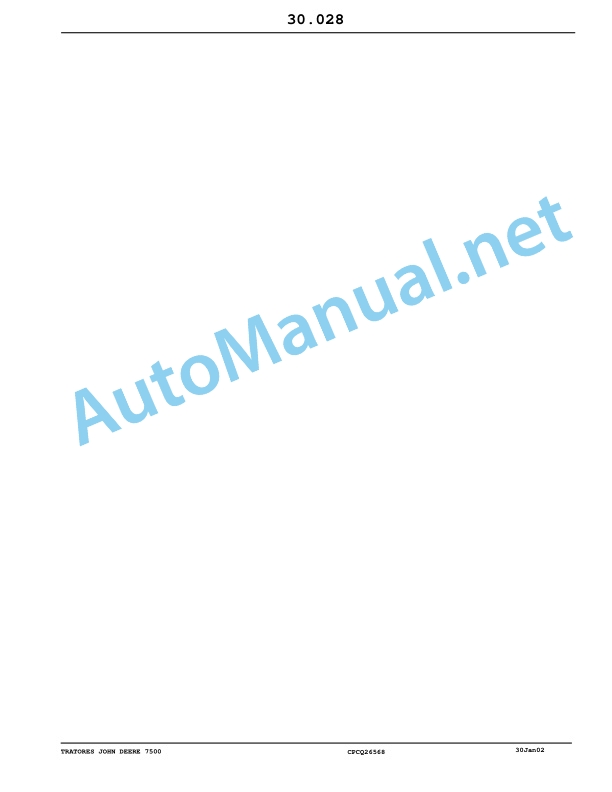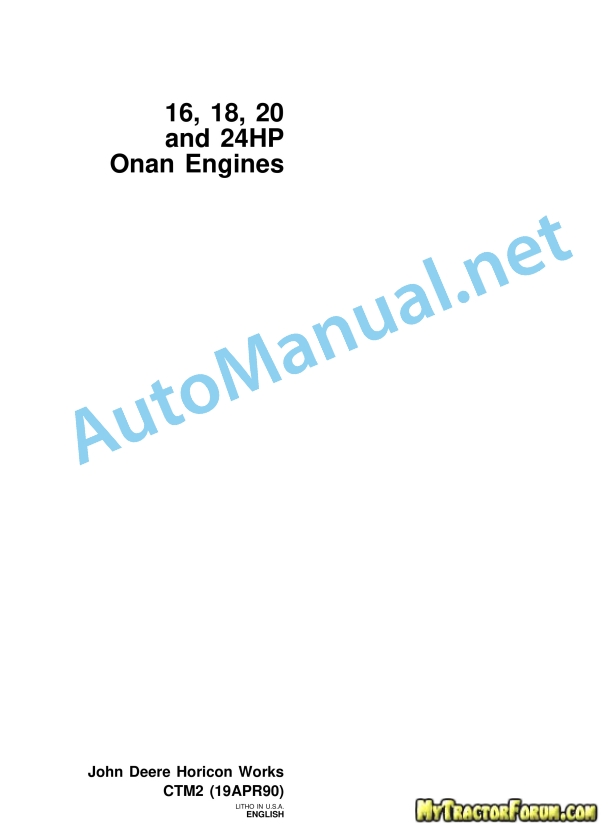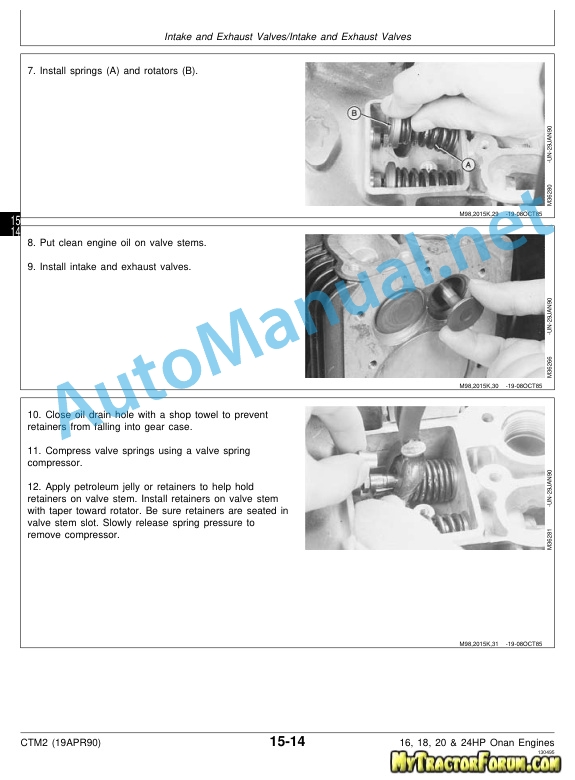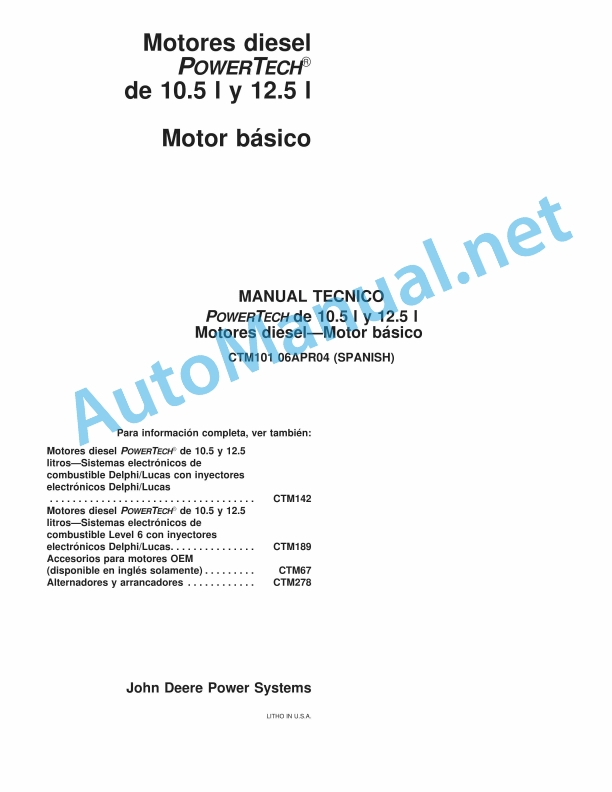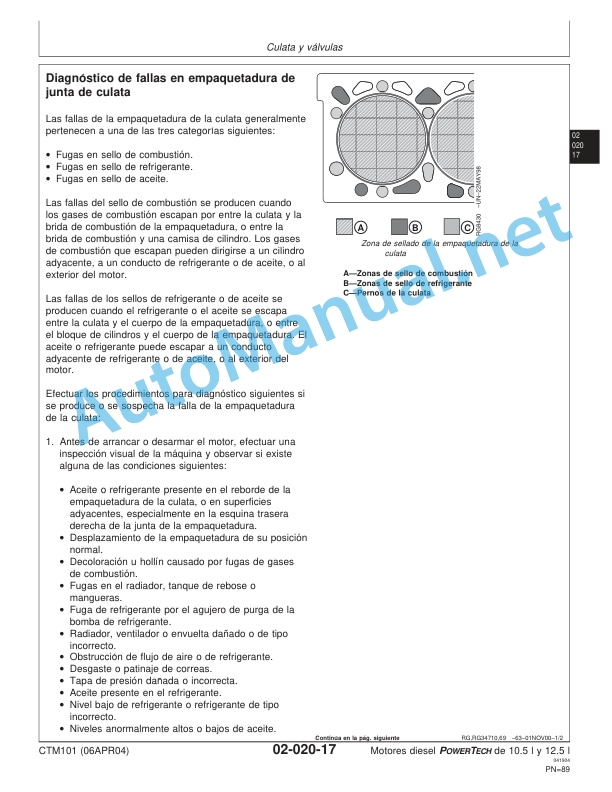Claas Rollant 375 355 Rc Uniwrap (766) Baler Operator Manual ES
$50.00
- Model: Rollant 375 355 Rc Uniwrap (766) Baler
- Type Of Manual: Operator Manual
- Language: ES
- Format: PDF(s)
- Size: 82.7 MB
File List:
00 0291 354 7.pdf
00 0294 498 4.pdf
00 0291 354 7.pdf:
ROLLANT 375 Uniwrap
1. Introduction
1.1 General information
1.1.1 Application of this user manual
1.1.2 Information relating to this instruction manual
1.1.3 Symbols and indications
1.1.4 Optional equipment
1.1.5 Qualified specialized workshop
1.1.6 Maintenance instructions
1.1.7 Information regarding warranty
1.1.8 Spare parts and technical questions
1.2 Proper application of the machine
1.2.1 Authorized use
1.2.2 Reasonably foreseeable misuse
2 Security
2.1 Recognize warning signs
2.1.1 Danger symbols
2.1.2 Keyword
2.2 Safety instructions
2.2.1 Meaning of the instruction manual
2.2.2 Observe graphic danger symbols and alarm indications
2.2.3 Requirements for all people working with the machine
2.2.4 Children in danger
2.2.5 Danger zones
2.2.6 Position yourself between the tractor and the machine
2.2.7 Accompanying persons
2.2.8 Couple the tractor with the machine
2.2.9 Risk of injury due to rotating shafts
2.2.10 Construction changes
2.2.11 Optional equipment and spare parts
2.2.12 Control of the tractor in operation
2.2.13 Use only after correct start-up
2.2.14 Technical status
2.2.15 Danger due to machine breakdowns
2.2.16 Comply with technical limit values
2.2.17 Danger due to coasting parts
2.2.18 Keep protective devices operational
2.2.19 Personal protective equipment
2.2.20 Wear appropriate clothing
2.2.21 Remove dirt and loose objects
2.2.22 Prepare the machine for road traffic
2.2.23 Dangers when driving on the road and in the countryside
2.2.24 Park the machine safely
2.2.25 Parking without supervision
2.2.26 Consumables that do not meet the requirements
2.2.27 Safe handling of consumables and auxiliary materials
2.2.28 Environmental protection and waste disposal
2.2.29 Fire protection
2.2.30 Very dangerous electrical discharge from overhead power lines
2.2.31 Electrical shock from electrical equipment
2.2.32 Liquids under pressure
2.2.33 Pressurized air
2.2.34 Hot surfaces
2.2.35 Work only on the stopped machine
2.2.36 Maintenance work and repair work
2.2.37 Machine parts and lifted loads
2.2.38 Risks derived from welding work
2.3 Graphic danger symbols
2.3.1 Structure of graphic hazard symbols
2.3.2 Location of safety stickers
2.3.3 Location of safety stickers
3 Machine Description
3.1 Existing models
3.1.1 Name of the machines
3.2 Overview and functions
3.2.1 Left side
3.2.2 Right side
3.2.3 Identification of the rollers
3.3 Safety equipment
3.3.1 Signal lighting
3.3.2 Reflective equipment
3.3.3 Chocks
3.3.4 Parking brake
3.3.5 Surety
3.3.6 Tailgate lock
3.3.7 Locking the pick-up
3.3.8 Fire extinguisher
3.3.9 Emergency stop
3.3.10 Safety arm
3.4 Work and service positions
3.4.1 General information
3.4.2 Front of the baler
3.5 Identification plate and serial number
3.5.1 Spare parts and technical information
3.5.2 Serial number
3.5.3 Identification plate
3.5.4 Axle identification plate
3.5.5 Rudder identification plate*
3.6 General operating principle
3.6.1 General aspects
3.6.2 Bale pressing cycle
3.6.3 Bale wrapping cycle
3.6.4 Complete bale pressing-wrapping cycle
3.6.5 Coating
3.6.6 Working modes
3.7 Control terminal
3.7.1 Control terminal
3.7.2 ISOBUS connection
3.7.3 EASY on board
3.8 Trailer support
3.8.1 Types of fixing
3.9 Transmission and drive
3.9.1 Power transmission
3.9.2 Main drive
3.9.3 Pick-up drive
3.9.4 Rotor drive
3.9.5 Drive Chains
3.10 Harvest harvest
3.10.1 Pick-up
3.10.2 Compactor
3.10.3 Short straw plank (optional)
3.10.4 Reducer roller (option)
3.11 Power supply unit
3.11.1 Rotor
3.11.2 Rotor structure with oscillating floor
3.11.3 RotoCut cutting device
3.11.4 Automatic cleaning of the RotoCut blades (option)
3.12 Pressing system
3.12.1 Pressing chamber and rollers
3.12.2 Pressing cycle
3.13 Tying system
3.13.1 Tying categories and types
3.13.2 Comfort binding
3.13.3 Tying adjustment
3.13.4 Thread box (depending on equipment)
3.13.5 Mesh reserve
3.13.6 Mesh compartment
3.14 Bale wrapper
3.14.1 Reminder
3.14.2 Wrapping adjustment
3.14.3 Tilter
3.14.4 Wrapping table
3.14.5 Wrapping arm
3.14.6 Stretcher
3.14.7 Plastic tape cutter
3.14.8 Wrapping Plastic Tape Box
3.15 Lubrication system (oil)
3.15.1 Automatic chain lubrication
3.16 Lubrication system (grease)
3.16.1 General information
3.16.2 Manual centralized lubrication (option)
3.16.3 Centralized automatic lubrication (option)
3.16.4 Electric centralized automatic lubrication (option)
3.17 Brake
3.17.1 General information
3.17.2 Hydraulic braking
3.17.3 Active hydraulic braking
3.17.4 Pneumatic braking
3.18 Hydraulic system
3.18.1 Baler Hydraulic Block
3.18.2 Hydraulic block of the wrapper
3.18.3 Continuous hydraulic circulation
3.18.4 Load Sensing (optional)
3.19 Equipment
3.19.1 Ladder
3.19.2 Stirrup
3.19.3 Pressure gauge
3.19.4 Electronic module
3.19.5 Plastic Wrap Tape Compensator
3.19.6 Stretcher 82% (option)
3.19.7 Bale turner (option)
3.19.8 Three-way valve (machines with rotator)
3.19.9 Anti-accumulation axis
3.19.10 Bale depositing mat (option)
3.19.11 Work focus (option)
3.19.12 Registration (depending on the country)
4 Control and display instruments
4.1 COMMUNICATOR II
4.1.1 Presentation
4.1.2 Description of the CLAAS COMMUNICATOR Using menus
4.2 ISOBUS terminal
4.2.1 Presentation
4.2.2 General information
4.3 CLAAS Medium Terminal
4.3.1 Presentation
4.3.2 Screen
4.3.3 Key identification
4.3.4 Home page
4.3.5 Description of the CLAAS Medium Terminal menus
4.4 EASY on board
4.4.1 Presentation
4.4.2 General information
5 Technical data
5.1 Baler
5.1.1 Dimensions
5.1.2 Weight
5.1.3 Hookup
5.1.4 Cardan shaft
5.1.5 Feeding and pressing
5.1.6 Tying device
5.1.7 Wrapper
5.1.8 Plastic wrapping tape
5.1.9 Wheels
5.1.10 Hydraulic circuit
5.1.11 Screw tightening torques
5.1.12 Braking
5.1.13 Greasing and lubrication
5.1.14 Sound levels
5.2 Safety devices
5.2.1 Security screw
5.2.2 Torque limiter
5.2.3 Wrapping machine
5.3 Inputs
5.3.1 Lubricants
5.4 Tractor
5.4.1 Required power
5.4.2 Authorized mass of the towing vehicle – TÜV approval*
5.4.3 Hooking
5.4.4 PTO
5.4.5 Electrical connections
5.4.6 Hydraulic connections
5.4.7 Hydraulic circuit and oil
5.4.8 Braking
6 Preparation of the machine
6.1 Turn off the machine and secure it
6.1.1 Stop and secure the tractor and machine
6.2 Adapt the tractor
6.2.1 Check the tractor power take-off protection device
6.2. dapt the tractor’s pneumatic brake equipment
6.2.3 Assemble COMMUNICATOR II*
6.2.4 Battery cable*
6.3 Adapt the machine
6.3.1 Recommendations
6.3.2 Adaptation of the fork hitch / swing bar hitch
6.3.3 Cardan shaft coupling
6.3.4 Adaptation of the cardan shaft length
6.3.5 Transformation kit, 8 grooves*
6.4 Hooking up the machine
6.4.1 Cardan shaft safety regulations
6.4.2 Rubber buffer
6.4.3 Positioning the cardan shaft
6.4.4 Identification of hydraulic hoses
Machine not equipped with
Tractor with constant pressure hydraulic system
Machine equipped with
6.4.5 Connection to the tractor hydraulic distributors
Machine not equipped with
Machine equipped with
Machine equipped with
Tractor with constant pressure hydraulic system
6.4.6 Hydraulic brake
6.4.7 Active hydraulic brake
6.4.8 Air brake
6.4.9 Identification of electrical cables
6.4.10 Lighting
6.4.11 Power supply to the baler and COMMUNICATOR*
6.4.12 Baler power supply with ISOBUS cable
6.4.13 Baler power supply with
6.5 Prepare for use at work
6.5.1 Pick-up wheels
6.5.2 Pick-up height
6.5.3 Compactor
6.6 Tying with thread
6.6.1 Yarn quality
6.6.2 Preparation
6.6.3 Thread tensioner adjustment
6.6.4 Thread placement
6.6.5 Attaching the side thread stop
6.6.6 Selection of tying with comfort thread
6.7 Tying with mesh
6.7.1 Preparation
6.7.2 Mesh placement
6.7.3 Mesh roll brake adjustment
6.7.4 Selection of tying with comfort mesh
6.8 Pressing chamber
6.8.1 Bale start stops
6.8.2 MPS adjustment
6.9 Cutting device
6.9.1 Safety regulations
6.9.2 Control
6.9.3 Placing the blades
RotoCut Baler with Oscillating Rotor Floor
6.9.4 Placing the false blades*
6.9.5 Unused blades and dummy blades
6.10 Bale wrapper
6.10.1 Placing the roll of plastic wrapping tape
6.10.2 Placing the plastic wrapping tape on the cutter
6.10.3 Coating
6.10.4 Unlocking the tilter
6.11 Load the machine
6.11.1 Baler stowage
6.11.2 Lifting points
6.11.3 Elevation
7 Management
7.1 General information
7.1.1 Reminder
7.1.2 Baler user
7.1.3 Side doors
7.1.4 Plastic tape box doors
7.2 Movements with the baler
7.2.1 Equipment control
7.2.2 Preparation for transport
7.2.3 Road travel
7.2.4 Arrival at the field
7.2.5 Moving around the field
7.2.6 Parking
7.3 Before each use
7.3.1 Cardan shaft
7.3.2 Reminders
7.3.3 Baler maintenance
7.3.4 Equipment control
7.3.5 Safety devices
7.4 Commissioning in the field
7.4.1 Usage tips
7.4.2 Hydraulic tilter lock valve
7.4.3 Three-way valve (machine with rotator)
7.4.4 Bale turner (option)
7.4.5 Bale depositing mat (option)
7.4.6 Commissioning of the machine
7.4.7 Coating adjustment
7.5 Pick-up
7.5.1 Important
7.6 Tied
7.6.1 Changing the mesh roll
7.7 Bale parameters
7.7.1 Bale settings
7.8 COMMUNICATOR II
7.8.1 Selection of tying with thread or mesh (optional)
7.8.2 Settings Menu
Baler usage parameters
Pressing parameters
Tying type selection
Number of loops of mesh or thread (optional)
Adjustment
Tying time
Adjustment
Automatic pressure recharge
Adjustment
Automatic blade cleaning
Adjustment
Automatic gate opening
Adjustment
Interval between two lubrications (machines equipped with electric lubrication)
Adjustment
Parameters of use of the wrapping machine
Wrapper parameters
Working modes
Adjustment
Automatic bale unloading
Adjustment
Number of turns of the plastic tape
Adjustment
Plastic tape compensator
Adjustment
7.8.3 Counters Menu
Maintenance indicator reset
Maintenance indicator
7.8.4 Choice of exploitation area
7.8.5 Name of the work
7.8.6 Print customer or operating area data
7.8.7 Pick-up
7.8.8 Pressure recharge
7.8.9 RotoCut cutting device
7.8.10 Oscillating rotor floor
7.8.11 Manual activation of the tying process
Early activation of tying
Tying delay
Programmable keys
7.8.12 Electric centralized lubrication (optional)
7.8.13 Pressing process – tying
Stages of the pressing – tying process
Stages of tying with comfort mesh
Stages of tying with comfort thread
7.8.14 Depositing bales in the wrapper
7.8.15 Wrapping process – bale unloading
Stages of the wrapping process
Wrapping stages
Wrapper status
7.8.16 Automatic/Manual Control
7.8.17 Manual wrapping
7.8.18 Placing the wrapping arm in its initial position
7.8.19 Plastic tape compensator
7.8.20 Work focus (optional)
7.8.21 Faults
7.8.22 Functions assignable to programmable keys
7.9 ISOBUS terminal
7.9.1 General information
7.10 EASY on board
7.10.1 General information
7.11 UNIWRAP control console
7.11.1 Automatic control
7.11.2 Adjustment of wrapping parameters
Parameter adjustment
Number of turns of the plastic tape
Cutters opening time
Plastic tape compensator
Table speed in plastic tape compensator mode
Working mode
Automatic bale unloading
Work with or without bale turner
7.11.3 Auto/Manu Mode
7.11.4 Manual controls
7.11.5 Resumption of an interrupted wrap
7.11.6 Condition of the wrapper sensors
7.11.7 Faults
7.11.8 Wrapping process – bale unloading
7.12 Unclogging the baler
7.12.1 How to avoid traffic jams?
7.12.2 Safety regulations
7.12.3 Unjamming the pick-up
7.12.4 Unclogging the rotor
Unclogging due to decreased pressure (at the end of the bale)
Unclogging by deactivating the RotoCut blades
Unclogging by opening the oscillating floor
Programmable keys
7.13 After use
7.13.1 Reminders
7.13.2 Securing the baler
7.13.3 Daily cleaning
7.13.4 Storage of plastic tape rolls
7.13.5 Storage and handling of plastic wrapping tape rolls
7.13.6 Cleaning the stretcher
7.14 Unhooking the machine
7.14.1 Disconnecting the baler
8 Incident and solution
8.1 General information
8.1.1 Sensors
8.2 COMMUNICATOR II
8.2.1 General information
8.2.2 Tying with mesh
8.2.3 Tying with thread
8.2.4 Cutting depth
8.2.5 Wrapping machine
8.3 UNIWRAP control console
8.3.1 General aspects
8.3.2 Wrapper
8.4 Tying system
8.4.1 Origin of problems
8.4.2 Tying with mesh
8.4.3 Tying with thread
8.5 Lubrication system
8.5.1 Origin of problems
8.5.2 Troubleshooting
8.6 Greasing system
8.6.1 Centralized lubrication
8.7 Bale wrapper
8.7.1 General aspects
8.7.2 Wrapping
8.8 Other functions
8.8.1 General functions
9 Maintenance
9.1 General maintenance instructions
9.1.1 Maintenance and safety tips
9.1.2 Wheels and tires
9.1.3 Brakes
9.1.4 Hydraulic circuit
9.1.5 V-belt
9.1.6 Chains
9.1.7 Pressing and tying device
9.1.8 Hitch
9.1.9 Cardan shaft
9.1.10 Cutting device
9.1.11 Protection devices
9.1.12 Screws and nuts
9.1.13 Lubricants and greasing
9.1.14 Inductive sensors
9.1.15 Welding work
9.1.16 Spare parts
9.2 Maintenance tables
9.2.1 Maintenance operations before harvest
9.2.2 Maintenance operations after the first 10 hours of service
9.2.3 Maintenance operations after the first 50 hours of service
9.2.4 Maintenance operations every 8 hours of service or every day
9.2.5 Maintenance operations every 50 hours of service
9.2.6 Maintenance operations every 100 hours of service
9.2.7 Maintenance operations every 250 hours of service
9.2.8 Annual maintenance operations or every 500 hours of service
9.2.9 Maintenance operations if necessary
9.3 Greasing scheme
9.3.1 Greasing
9.3.2 Grease points – 8 h
9.3.3 Greasing points – 50 h
9.3.4 Grease points – 100 h
9.3.5 Grease points – 250 h
9.4 Gear maintenance operations
9.4.1 Drive box 540 rpm
9.4.2 Drive box 1,000 rpm
9.4.3 Cardan shaft security screw
Replacing the screw
9.5 Axle and wheel maintenance operations
9.5.1 Tire check
9.5.2 Checking wheel tightening
9.5.3 Changing the wheels
9.5.4 Wheel hub
9.6 Brake maintenance operations
9.6.1 Hydraulic and active hydraulic braking
9.6.2 Pneumatic braking
9.6.3 Replacing the brake linings
9.7 Hitch device maintenance operations
9.7.1 Fixing the hitch hole and rudder
9.8 Hydraulic system maintenance operations
9.8.1 Filter
9.9 Pick-up maintenance operations
9.9.1 Pick-up drive chains
9.9.2 Pick-up security screw
9.9.3 Pick-up tensioner
9.10 Maintenance operations on the power supply unit
9.10.1 Rotor drive spring
9.11 Pressing chamber maintenance operations
9.11.1 MPS springs (oscillating segment)
9.11.2 Roller drive springs
9.11.3 Cleaning the roller
9.12 Tying maintenance operations
9.12.1 Tying with thread
9.12.2 Tying with mesh
9.13 Lubrication system maintenance operations
9.13.1 Chain lubrication
9.14 Maintenance operations of the lubrication system
9.14.1 Manual lubrication
9.14.2 Manual centralized lubrication of the bearings (optional)
9.14.3 Centralized automatic lubrication of bearings (optional)
9.14.4 Electric automatic centralized lubrication (optional)
9.15 Bodywork maintenance operations
9.15.1 Fire extinguisher (optional)
9.16 Wrapping machine maintenance operations
9.16.1 Security
9.16.2 Checking the wear of the wrapping table belts
9.16.3 Belt repair
9.16.4 Safety arm
9.16.5 Wrapping arm sensors
9.16.6 Deviation between extruder and cutters
9.16.7 Stretcher sensor
9.16.8 Bale presence sensor on the tilter
9.16.9 Tilter low position stop
9.16.10 Tilter low position sensor
9.16.11 Bale presence sensor on the wrapping table
9.16.12 Wrapping table sensor
9.16.13 Opening angle of plastic tape cutters
9.16.14 Plastic tape cutter springs
9.16.15 Wrapping arm drive box
9.16.16 Check the fixation of the arm and its drive
9.17 Hibernation
9.17.1 General information
9.17.2 Cleaning
9.17.3 Greasing
9.17.4 Maintenance
9.17.5 Storage
10 Decommissioning and waste disposal
10.1 General information
10.1.1 Decommissioning and waste disposal
11 EC declaration of conformity
11.1 General information
11.1.1 Declaration of conformity for CE
00 0294 498 4.pdf:
ROLLANT 355 UNIWRAP
1 Regarding this instruction manual
1.1 General data
1.1.1 Validity of the manual
1.1.2 About this user manual
1.1.3 Technical characteristics
2 Security
2.1 General data
2.1.1 General information
2.1.2 Authorized use
2.1.3 Reasonably foreseeable misuse
2.1.4 Highway driving
2.1.5 Symbols applicable to danger indications
2.1.6 Safety regulations
2.1.7 Accident prevention
2.1.8 Waste disposal
2.1.9 Residual risks
2.2 Graphic danger symbols
2.2.1 Description
2.2.2 Location of safety stickers
2.3 Safety equipment
2.3.1 Signal lights
In the packing house
In the wrapper
2.3.2 Reflective equipment
2.3.3 Chocks
2.3.4 Parking brake
2.3.5 Surety
2.3.6 Tailgate lock
2.3.7 Locking the pick-up
2.3.8 Fire extinguisher
2.3.9 Emergency stop
2.3.10 Safety arm
3 Machine Description
3.1 Existing models
3.1.1 Name of the machines
3.2 Overview and functions
3.2.1 Left side
3.2.2 Right side
3.2.3 Identification of the rollers
3.3 Work and service positions
3.3.1 General information
3.3.2 Front of the baler
3.4 Identification plate and serial number
3.4.1 Spare parts and technical information
3.4.2 Serial number
3.4.3 Machine identification plate
3.4.4 Rudder identification plate (depending on equipment)
3.4.5 Axle identification plate (depending on equipment)
3.5 General operating principle
3.5.1 General information
3.5.2 Bale pressing cycle
3.5.3 Bale wrapping cycle
3.5.4 Complete bale pressing-wrapping cycle
3.5.5 Coating
3.5.6 Working modes
3.6 Control terminal
3.6.1 Control console
3.6.2 ISOBUS connection
3.7 Transmission and drive
3.7.1 Power transmission
3.7.2 Main drive
3.7.3 Pick-up drive
3.7.4 Rotor drive (optional)
3.7.5 Drive Chains
3.8 Reception of the harvest
3.8.1 Pick-up
3.8.2 Compactor
3.8.3 Short straw plank (optional)
3.8.4 Reducer roller (option)
3.9 Power set
3.9.1 Rotor
3.9.2 RotoCut cutting device (optional)
3.9.3 Automatic cleaning of the RotoCut blades (option)
3.9.4 Manual rotor reversal (optional)
3.9.5 Hydraulic rotor reversal (optional)
3.10 Pressing system
3.10.1 Pressing chamber and rollers
3.10.2 Pressing cycle
3.11 Tying system
3.11.1 Tying categories and types
3.11.2 Comfort binding
3.11.3 Tying adjustment
3.11.4 Thread compartment (depending on equipment)
3.11.5 Mesh reserve (depending on equipment)
3.11.6 Mesh compartment (depending on equipment)
3.12 Bale wrapper
3.12.1 Wrapping adjustment
3.12.2 Tilter
3.12.3 Wrapping table
3.12.4 Wrapping arm
3.12.5 Stretcher
3.12.6 Plastic tape cutter
3.12.7 Wrapping Plastic Tape Box
3.13 Centralized lubrication
3.13.1 Automatic chain lubrication
3.13.2 Centralized manual lubrication (option)
3.13.3 Centralized automatic lubrication (option)
3.14 Brake
3.14.1 General information
3.14.2 Hydraulic braking
3.14.3 Active hydraulic braking
3.14.4 Pneumatic braking
3.15 Hydraulic system
3.15.1 Baler Hydraulic Block
3.15.2 Hydraulic block of the wrapper
3.15.3 Continuous hydraulic circulation
3.15.4 Load Sensing (option)
3.16 Equipment
3.16.1 Ladder (depending on equipment)
3.16.2 Stirrup
3.16.3 Pressure gauge
3.16.4 Electronic module
3.16.5 Wrapper electrical box
3.16.6 Plastic Wrap Tape Compensator
3.16.7 Stretcher 82% (option)
3.16.8 Bale turner (option)
3.16.9 Three-way valve (machines with rotator)
3.16.10 Anti-accumulation axis
3.16.11 Bale depositing mat (option)
3.16.12 Work focus (option)
3.16.13 Registration (depending on the country)
4 Control and display instruments
4.1 CLAAS COMMUNICATOR
4.1.1 Presentation
4.1.2 General information
4.1.3 Screen
4.1.4 Key identification
4.1.5 Description of the CLAAS COMMUNICATOR General menu
4.1.6 Description of the CLAAS COMMUNICATOR Use menus
4.1.7 Description of the CLAAS COMMUNICATOR Service menu
4.2 ISOBUS terminal
4.2.1 Presentation
4.2.2 General information
4.3 UNIWRAP control console
4.3.1 Presentation
4.3.2 Key identification
4.3.3 UNIWRAP control console menus
5 Technical data
5.1 Baler
5.1.1 Dimensions
5.1.2 Weight
5.1.3 Hookup
5.1.4 Cardan shaft
5.1.5 Feeding and pressing
5.1.6 Tying device
5.1.7 Wrapper
5.1.8 Plastic wrapping tape
5.1.9 Wheels
5.1.10 Hydraulic circuit
5.1.11 Screw tightening torques
5.1.12 Braking
5.1.13 Greasing and lubrication
5.1.14 Sound levels
5.2 Safety devices
5.2.1 Security screw
5.2.2 Torque limiter
5.2.3 Wrapping machine
5.3 Tractor
5.3.1 Required power
5.3.2 Hooking
5.3.3 PTO
5.3.4 Electrical connections
5.3.5 Hydraulic connections
5.3.6 Hydraulic circuit and oil
5.3.7 Braking
6 Preparation of the machine
6.1 General data
6.1.1 First commissioning
6.1.2 Equipment control
6.2 Cardan shaft
6.2.1 Safety regulations
6.2.2 Cardan shaft adjustment
6.2.3 Adaptation of the cardan shaft length
6.2.4 Placing the cardan shaft
6.3 Trailer support
6.3.1 Recommendations
6.3.2 Types of fixing
6.3.3 Adaptation of the fork hitch / swing bar hitch
6.3.4 Rubber buffer
6.3.5 Placing the cardan shaft
6.4 Hydraulic connections
6.4.1 Machine not equipped with Load-Sensing
6.4.2 Machine equipped with Load-Sensing and tractor without Load-Sensing socket
6.4.3 Machine equipped with Load-Sensing and tractor with Load-Sensing sockets
6.4.4 Tractor equipped with a constant pressure hydraulic system
6.5 Electrical connections
6.5.1 Marking of electrical cables
6.5.2 Lighting
6.5.3 Battery cable (optional)
6.5.4 Power supply to the baler and CLAAS COMMUNICATOR
6.5.5 Baler power supply with ISOBUS cable
6.6 Brake
6.6.1 Hydraulic brake
6.6.2 Active hydraulic brake
6.6.3 Air brake
6.7 Tying with thread
6.7.1 Preparation
6.7.2 Thread tensioner adjustment
6.7.3 Thread placement
6.7.4 Positioning the side thread stop
6.7.5 Selection of tying with comfort thread
6.8 Tying with mesh
6.8.1 Preparation
6.8.2 Mesh placement
6.8.3 Mesh roll brake adjustment
6.8.4 Selection of tying with comfort mesh
6.9 Pressing chamber
6.9.1 Bale start stops
6.9.2 Regulation of the MPS
6.10 Cutting device
6.10.1 Safety regulations
6.10.2 Control
6.10.3 Placing the blades
6.10.4 Assembly of false blades (optional)
6.10.5 Unused blades and dummy blades
6.11 Bale wrapper
6.11.1 Activation of the wrapper on the control console
6.11.2 Placing the roll of plastic wrapping tape
6.11.3 Placing the plastic wrapping tape on the cutter
6.11.4 Coating
6.11.5 Unlocking the tilter
6.11.6 Unhooking the wrapper
6.11.7 Wrapper attachment
6.12 Machine loading
6.12.1 Baler stowage
6.12.2 Lifting points
6.12.3 Elevation
7 Management
7.1 General data
7.1.1 Baler user
7.1.2 Side doors
7.1.3 Plastic tape box doors
7.2 Movements with the baler
7.2.1 Equipment control
7.2.2 Preparation for transport
7.2.3 Road travel
7.2.4 Arrival at the field
7.2.5 Moving around the field
7.2.6 Parking
7.3 Before each use
7.3.1 Cardan shaft
7.3.2 Reminders
7.3.3 Baler maintenance
7.3.4 Equipment control
7.3.5 Safety devices
7.4 Commissioning in the field
7.4.1 Usage tips
7.4.2 Hydraulic tilter lock valve
7.4.3 Three-way valve (machine with rotator)
7.4.4 Bale turner (option)
7.4.5 Bale depositing mat (option)
7.4.6 Commissioning of the machine
7.4.7 Coating adjustment
7.5 Pickup
7.5.1 Important
7.5.2 Pick-up wheels
7.5.3 Pick-up height
7.5.4 Compactor
7.6 Tied
7.6.1 Selection of tying with thread or mesh (option)
7.6.2 Setting the number of thread turns
Machine equipped with comfort tying
7.6.3 Adjustment of the number of mesh turns
Machine equipped with comfort tying
7.7 Bale parameters
7.7.1 Bale settings
7.8 CLAAS COMMUNICATOR
7.8.1 Selection of tying with thread or mesh (option)
7.8.2 Bale parameter settings
Pressing parameters
Wrapper parameters
7.8.3 Counter Menu
Selection and adjustments of the work
7.8.4 Programmable keys
7.8.5 Pick-up
7.8.6 Cylinder pressure recharging
7.8.7 RotoCut cutting device
7.8.8 Manual activation of the tying process
Early activation of tying
Tying delay
7.8.9 Pressing-tying process
Stages of the pressing-tying process
7.8.10 Depositing bales in the wrapper
7.8.11 Wrapping process – bale deposit
Stages of the wrapping process
7.8.12 Auto/Manu Control
7.8.13 Manual wrapping
7.8.14 Plastic tape compensator
7.8.15 Work focus (Option)
7.8.16 Faults
7.8.17 Baler Diagnostics Submenu
7.9 ISOBUS terminal
7.9.1 General information
7.10 UNIWRAP control console
7.10.1 Wrapping parameter settings
Setting parameters
7.10.2 Counters Menu
7.10.3 Wrapping process – bale deposit
7.10.4 Working modes
7.10.5 Using the UNIWRAP control console
7.10.6 Manual control of the wrapper
7.10.7 Faults
7.10.8 Wrapper Diagnostics Submenu
7.11 Unclogging the baler
7.11.1 How to avoid traffic jams?
7.11.2 Safety regulations
7.11.3 Unclogging the pick-up
7.11.4 Unclogging the rotor
7.12 After use
7.12.1 Reminders
7.12.2 Baler protection
7.12.3 Daily cleaning
7.12.4 Disconnecting the baler
7.12.5 Storage of plastic tape rolls
7.12.6 Storage and handling of plastic wrapping tape rolls
7.12.7 Cleaning the stretcher
8 Incident and solution
8.1 General data
8.1.1 Sensors
8.2 CLAAS COMMUNICATOR
8.2.1 General aspects
8.2.2 Electrical circuit
8.2.3 Tying with mesh
8.2.4 Tying with thread
8.2.5 Thread knife
8.2.6 Wrapping machine
8.3 UNIWRAP control console
8.3.1 General aspects
8.3.2 Wrapper
8.4 Tying system
8.4.1 Origin of problems
8.4.2 Tying with mesh
8.4.3 Tying with thread
8.5 Lubricating oil system
8.5.1 Origin of problems
8.5.2 Troubleshooting
8.5.3 Centralized lubrication
8.6 Bale wrapper
8.6.1 General aspects
8.6.2 Wrapping
8.7 Other functions
8.7.1 General aspects
8.7.2 General functions
9 Maintenance
9.1 General maintenance instructions
9.1.1 Maintenance and safety tips
9.1.2 Wheels and tires
9.1.3 Brakes
9.1.4 Hydraulic circuit
9.1.5 V-belt
9.1.6 Chains
9.1.7 Pressing and tying device
9.1.8 Hitch
9.1.9 Cardan shaft
9.1.10 Cutting device
9.1.11 Protection devices
9.1.12 Screws and nuts
9.1.13 Lubricants and greasing
9.1.14 Inductive sensors
9.1.15 Welding work
9.1.16 Spare parts
9.2 Maintenance tables
9.2.1 Maintenance operations before harvest
9.2.2 Maintenance operations after the first 10 hours of service
9.2.3 Maintenance operations after the first 50 hours of service
9.2.4 Maintenance operations every 8 hours of service or every day
9.2.5 Maintenance operations every 50 hours of service
9.2.6 Maintenance operations every 100 hours of service
9.2.7 Maintenance operations every 250 hours of service
9.2.8 Annual maintenance operations or every 500 hours of service
9.2.9 Maintenance operations if necessary
9.3 Lubricant tables
9.3.1 Lubricants
9.4 Greasing scheme
9.4.1 Greasing
9.4.2 Grease points – 8 h
9.4.3 Greasing points – 50 h
9.4.4 Grease points – 100 h
9.4.5 Grease points – 250 h
9.5 Gear maintenance work
9.5.1 540 rpm drive box
9.5.2 Drive box 1,000 rpm
9.5.3 Cardan shaft security screw
Replacing the screw
9.6 Axle and wheel maintenance operations
9.6.1 Tire check
9.6.2 Wheel tightening check
9.6.3 Changing the wheels
9.6.4 Wheel hub
9.7 Brake maintenance operations
9.7.1 Hydraulic and active hydraulic braking
9.7.2 Pneumatic braking
9.7.3 Replacing the brake linings
9.8 Hitch device maintenance operations
9.8.1 Fixing the hitch hole and rudder
9.9 Hydraulic system maintenance operations
9.9.1 Filter
9.10 Pick-up maintenance operations
9.10.1 Pick-up drive chains
9.10.2 Pick-up security screw
9.10.3 Pick-up tensioner
9.11 Maintenance work on the power supply unit
9.11.1 Rotor drive spring
9.11.2 Adjusting the height of the blades (RotoCut Machines)
9.11.3 Rotor reversing device security screw (optional)
9.12 Pressing chamber maintenance operations
9.12.1 MPS springs (oscillating segment)
9.12.2 Roller drive springs
9.12.3 Cleaning the roller
9.13 Tying maintenance operations
9.13.1 Tying with thread
9.13.2 Tying with mesh
9.14 Maintenance operations of the centralized lubrication system
9.14.1 Chain lubrication
9.14.2 Centralized manual lubrication of bearings (option)
9.14.3 Centralized automatic lubrication of bearings (option)
9.15 Bodywork maintenance operations
9.15.1 Fire extinguisher (optional)
9.16 Wrapping machine maintenance operations
9.16.1 Security
9.16.2 Checking the wear of the wrapping table belts
9.16.3 Belt repair
9.16.4 Safety arm
9.16.5 Wrapping arm sensors
9.16.6 Deviation between extruder and cutters
9.16.7 Stretcher sensor
9.16.8 Bale presence sensor on the tilter
9.16.9 Tilter low position stop
9.16.10 Tilter low position sensor
9.16.11 Bale presence sensor on the wrapping table
9.16.12 Wrapping table sensor
9.16.13 Opening angle of plastic tape cutters
9.16.14 Plastic tape cutter springs
9.16.15 Wrapping arm drive box
9.16.16 Check the fixation of the arm and its drive
9.17 Hibernation
9.17.1 General information
9.17.2 Cleaning
9.17.3 Greasing
9.17.4 Maintenance
9.17.5 Storage
10 Decommissioning and waste disposal
10.1 General data
10.1.1 End of operational life and waste disposal
11 EU declaration of conformity
11.1 General data
11.1.1 Declaration of conformity for CE
John Deere Parts Catalog PDF
John Deere Tractors 6300, 6500, and 6600 Parts Catalog CQ26564 (29SET05) Portuguese
John Deere Repair Technical Manual PDF
John Deere Parts Catalog PDF
John Deere Harvesters 8500 and 8700 Parts Catalog CPCQ24910 Spanish
John Deere Repair Technical Manual PDF
John Deere Repair Technical Manual PDF
John Deere Application List Component Technical Manual CTM106819 24AUG20
John Deere Repair Technical Manual PDF
John Deere DF Series 150 and 250 Transmissions (ANALOG) Component Technical Manual CTM147 05JUN98
New Holland Service Manual PDF
John Deere Parts Catalog PDF
John Deere Tractors 7500 Parts Catalog CPCQ26568 30 Jan 02 Portuguese
John Deere Repair Technical Manual PDF
John Deere 16, 18, 20 and 24HP Onan Engines Component Technical Manual CTM2 (19APR90)
John Deere Repair Technical Manual PDF
